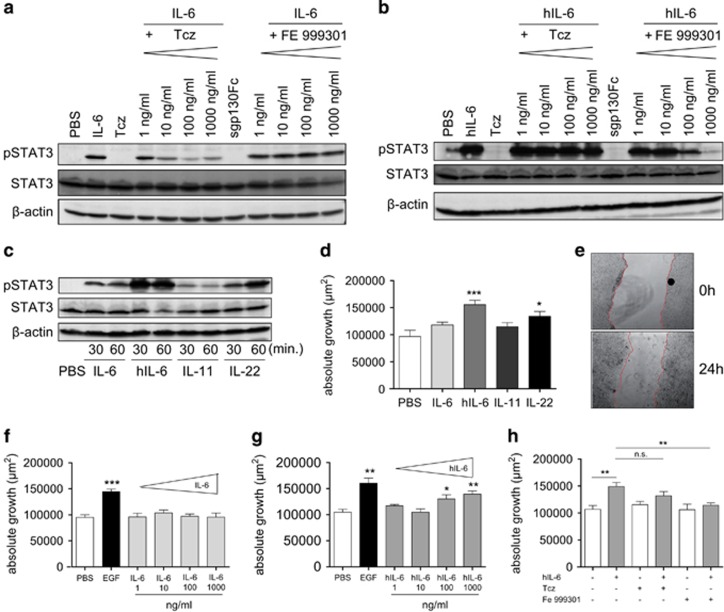Figure 1.
Functional classic IL-6 signalling in IECs does not lead to increased cellular proliferation. (a) Tcz inhibits STAT3 phosphorylation (pSTAT3) after induction of classic signalling in a dose-dependent manner. Western blot analysis of lysates from HT-29 colon carcinoma cells, pre-treated with Tcz (1–1000 ng/ml) or sgp130Fc (1–1000 ng/ml) for 6 h and stimulated with human IL-6 (100 ng/ml) for 30 min. (b) sgp130Fc dose-dependently blocks trans-signalling: western blot analysis of lysates from HT-29 colon carcinoma cells, pre-treated with Tcz or sgp130Fc (1–1000 ng/ml) for 6 h and stimulated with hyper-IL-6 (hIL-6) (10 ng/ml) for 30 min. (c) HT-29 colon carcinoma cells were stimulated with IL-6 (100 ng/ml), hIL-6 (100 ng/ml), IL-11 (100 ng/ml) or IL-22 (100 ng/ml) for 30 or 60 min, and protein lysates were probed for (p)STAT3, STAT3 or β-actin. (d) IL-6 trans-signalling and IL-22, but not IL-6 classic signalling or IL-11 induce epithelial regeneration: confluent HT-29 cells (n=8 wells/stimulation) were scratched with a sterile 200 μl pipette and stimulated with IL-6 (100 ng/ml), hIL-6 (100 ng/ml), IL-11 (100 ng/ml) or IL-22 (100 ng/ml) for 24 h. Absolute and relative growth was assessed 24 h after scratching. (e) Representative photomicrographs were taken at 0 and 24 h after scratch induction in PBS-treated HT-29 cells. (f) IL-6 classic signalling does not alter intestinal epithelial proliferation and migration: absolute growth of HT-29 colon carcinoma cells after scratching with a sterile pipette and treatment with human EGF (10 ng/ml) or IL-6 (1–1000 ng/ml) for 24 h (n=8 wells per stimulation). (g) IL-6 trans-signalling increases intestinal epithelial proliferation and migration: HT-29 colon carcinoma cells were scratched and stimulated with human EGF (10 ng/ml) or hIL-6 (1–1000 ng/ml), and absolute growth was assessed after 24 h (f). (h) sgp130Fc, but not Tcz, inhibits hIL-6-induced epithelial proliferation and migration: HT-29 colon carcinoma cells were pre-incubated with Tcz (1000 ng/ml) or sgp130Fc (1000 ng/ml) for 4 h, scratched and stimulated with hIL-6 (100 ng/ml), and absolute growth was assessed after 24 h (n=8 wells per stimulation). Note the slight variations of absolute growth between g, h, which results from biological replicates of the experiment. Data are representative of n=2 individual experiments. Significance was determined using the two-tailed Student's t-test, and data are expressed as mean±s.d. *P<0.05; **P<0.01; ***P<0.001.

